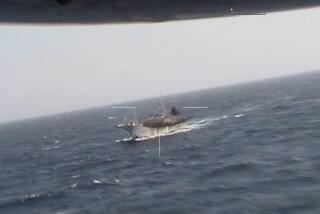Sailing along ...Denise WISHNEY fondly recalls the...
Sailing along ...
Denise WISHNEY fondly recalls the day last April when she caught 17 sailfish off Costa Rica. “The fish were just everywhere,” she said. “It was hard ... but it was fun.”
It was also rewarding, she adds, because all 17 of those fish -- assuming they’re still alive -- and many others are swimming around with scientific tags that help track the migration habits of the species. On Feb. 13 in Florida, the Billfish Foundation will honor Wishney as the top female tagger for 2003. While fishing mostly off Panama, Costa Rica and Guatemala, she tagged and released 212 sailfish. The runner-up, with 51, was Kate Astle of Battleground, Wash. The top male finisher, Roger Hamlin of Guatemala, tagged 788.
“Because billfish are such highly migratory creatures, it’s very important to have recreational anglers willing to participate in this type of hands-on research,” said Ellen Peel, president of the Billfish Foundation, a Fort Lauderdale, Fla.-based conservation and research organization. “By their efforts, and through our recapture efforts, we’re able to obtain a considerable amount of data that can be looked at by scientists.”
Wishney is no newcomer to tagging. Although she and husband, Peter, list their home as Capistrano Beach, for the last two years they’ve resided mostly aboard their 44-foot Pacifica, the Foxi Lady.
In 2002, Denise, with Peter Wishney as captain, visited 18 countries in an attempt to make history. She tagged and released 122 white marlin, 50 blue marlin, 22 sailfish, one Atlantic spearfish and one swordfish. She became the first woman to be named angler of the year in the Atlantic division by Irvine-based AFTCO Manufacturing Co., which recognizes conservation efforts in the Atlantic and Pacific oceans. She was also the Billfish Foundation’s top female tagger in 2002.
Her most recent effort began last January. The pair took the boat through the Panama Canal to the Pacific, beginning a trek home that wouldn’t end until December. The couple took a wedding break in August in Sun Valley, Idaho, where they spent a week celebrating their togetherness and time on land. They did a little kayaking and golfing, but temptation got the best of them. “We also did some trout fishing,” Denise Wishney confesses.
This year they plan to spend more time at home, but temptations abound: the summertime abundance of striped marlin in the Sea of Cortez and the fall gathering of that species just beyond Magdalena Bay on the Pacific coast of Baja California. “We may also go back to Costa Rica,” she said. “But we’re definitely going to be commuting more this year -- because it’s time to be spending at least some time at home.”
More triple digits
Joyce CORRIGAN is often the only woman on the Royal Polaris, a long-range sportfishing vessel that spends up to three weeks at a time in remote locations off Mexico, in seas that can be rough enough to make the most seasoned veterans turn green. But she is hardly intimidated and, in fact, is looked up to by most of those men.
That’s because Corrigan, 59, is as seasoned as anyone on the specialized trips targeting the world’s largest yellowfin tuna. And she often out-fishes the men.
That was the case during the most recent 18-day voyage, which ended at Fisherman’s Landing in San Diego last week with a 310-pound yellowfin tuna as its largest catch. Corrigan landed the behemoth after a two-hour fight, during which she had to board a skiff to get a better angle on the fish, which had gone under the boat in an attempt to break the line. “It was a nice surprise to get a big fish again,” she said last week after returning to her Cerritos home.
It was the second 300-pounder for Corrigan, whose previous best was a 304-pounder, caught in 1993 aboard the same boat. “With that fish it felt like I was pulling a car out of the ocean,” she said. That catch, made on 130-pound-test monofilament, was approved as a line-class world record. Using the skiff disqualified her latest catch from record consideration.
Corrigan’s was one of two Royal Polaris catches to top 300 pounds -- Shigeo Ishibashi of Woodland Hills caught a 309-pounder. Two also came over the rail on the Red Rooster III’s most recent excursion: a 327-pounder by Bob Michener of Woodland Hills and a 312-pounder by Art Green of Newport Beach.
That brings to six the number of “super cows” for San Diego’s fleet, with five months remaining in the season. There were only two 300-pounders in each of the previous two seasons.
Busy waterways
California boaters are second to Michigan no longer in numbers. There were 1,051,606 registered boaters in California in 2002, a 9.8% increase over 2001, according to a survey released by the National Marine Manufacturers Assn. That puts the Golden State at No. 1 nationally and ahead of Michigan for the first time since the NMMA started issuing its U.S. Recreational Boat Registration Statistics Report in 1996.
Michigan’s number: 1,000,337. Florida, Minnesota and Wisconsin round out the top five. Nationally, there were 13 million registered recreational boats, a 1.2% increase over 2001.
Finger food
Florida dive master Randy Jordan won’t be touching any more fish for the benefit of his clients. During a recent scuba outing, Jordan had part of his pinkie finger bitten off while trying to coax a porcupine puffer from a hole so others could see it. When stroking the head of the fish failed to lure it into the open, the instructor waggled his fingers in front of it. The fish, whose teeth are designed for crushing shells, sliced through his finger without cutting the glove. In the January issue of the newsletter Undercurrent, Jordan stated the obvious: “Touching fish is not good for them and may not be good for you.”
To e-mail Pete Thomas or read his previous Fair Game columns, go to latimes.com/petethomas.
More to Read
Sign up for The Wild
We’ll help you find the best places to hike, bike and run, as well as the perfect silent spots for meditation and yoga.
You may occasionally receive promotional content from the Los Angeles Times.






